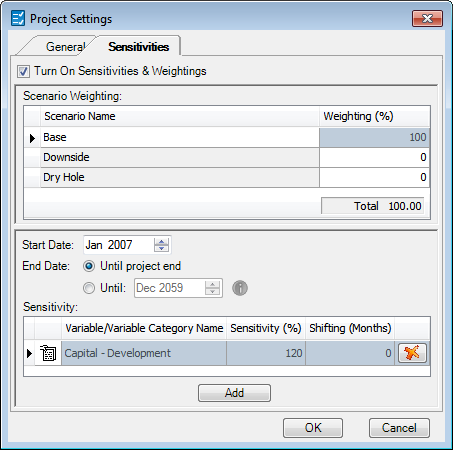Project sensitivities
The Sensitivities tab of the Project Settings window allows you to specify scenario weightings,
variable sensitivities and shifting. To specify these settings, click on 

If your project contains several scenarios, you can specify their weightings in the Scenario Weighting table. Project weightings apply a factor (specified as a percentage) to the project results. For example, an exploration project might have a success scenario weighted at 70% (chance of success), and a dry hole scenario weighted at 30% (chance of failure). Weightings are applied when you calculate the project. They can range from -100,000 to 100,000 and the total weighting can exceed 100%.
Project weightings are commonly used to generate an EMV using low, base and high scenarios, for example, a Swanson's Mean (30 40 30). It can also be used to generate risked results for a dry hole or fail case scenarios.
In the bottom table you can specify sensitivities and shifting for individual variables and variable categories. These settings are used when you want to see, for example, what will happen if capex is 10% higher than defined in the projects, and development starts 4 months later than planned.
Sensitivities range from -1000% to 1000%. Shifting moves values by a specified number of months. It ranges from -1,188 to 1,188 months.
To add a variable or a variable category to which sensitivities and shifting will be applied, click on a cell in the Variable/Variable Name Column, select a variable or a category in the pop-up window, then edit values in the Sensitivity and Shifting columns. To remove an item from the table, click on 
The start and end dates define the time frame to which sensitivities are applied. They are taken from the default user settings (see Default Settings). Note that the end date applies only to sensitivities and not to shifting.